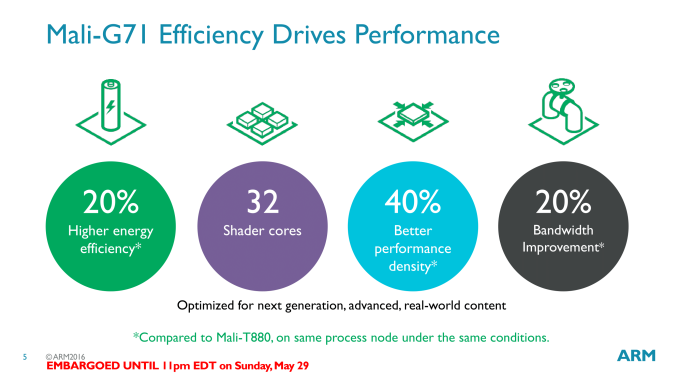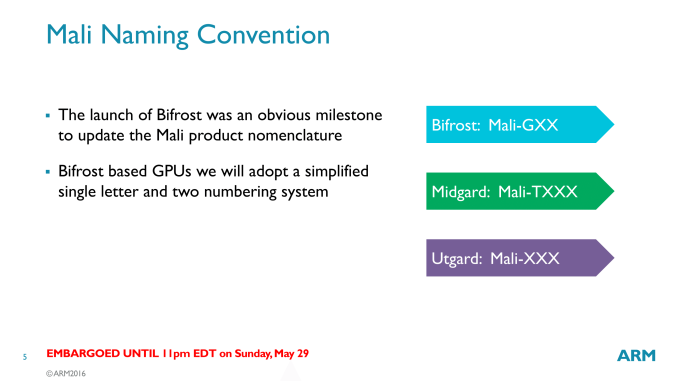ARM Unveils Next Generation Bifrost GPU Architecture & Mali-G71: The New High-End Mali
by Ryan Smith on May 30, 2016 7:00 AM ESTWrapping Things Up: Mali-G71, Coming Soon
Like ARM’s associated Cortex-A73 announcement, today’s Mali-G71 revelations are being made ahead of actual silicon availability. To that end a lot of ARM’s projections are based on early prototyping of manufacturing process and architectural simulations, though at this late stage those simulations tend to be pretty close.
ARM’s official numbers for G71 call for it to offer significant improvements over a same-process Mali-T880 with respect to both energy efficiency and density. For the former ARM is expecting G71 to deliver 20% better energy efficiency over T880, and on the latter to offer 40% better performance density – or in other words, the same performance at 40% less die space. Though ARM has not been heavily penalized for area efficiency, the latter has been one of the few areas where they haven’t done quite as well, and is something competitor Qualcomm is keen to call them out on.
From a performance standpoint, ARM is expecting G71-based devices to offer around 1.5x the performance of current, T880 devices. This is a slightly fuzzier metric – it’s not 50% faster at the same MP configuration – but rather a combination of manufacturing improvements, a larger number of shader cores, and Bifrost architectural improvements. Andrei also suspects that if we were looking at apples-to-apples ISO-power/ISO-area numbers where everything was held equal, the actual performance gains would be even greater.
With all of that said, expect to see G71 operate a lot like a drop-in replacement for current Mali GPUs when it comes to graphics. Bifrost is an architectural update for Mali rather than a feature update. There are no major graphics features that G71 supports that T880 does not; both deliver on the same OpenGL ES and Vulkan graphics functionality. The heterogeneous compute functionality on the other hand stands to make a big impact for general compute tasks, just not for graphics.
Ultimately what this gets ARM is a chance to recalibrate their architecture for the future, to better align with both what software developers are writing and what device manufacturers need in their GPUs. Bifrost is the new modern Mali, and the shift to a TLP-centric design should serve ARM well in the future based on what we’ve seen similar shifts do for AMD and others. Meanwhile the overall performance gains will allow ARM and its customers to hedge their bets on things such as 4K phones and mobile VR, giving them a more suitable GPU design to use if those innovations prove popular.
Wrapping things up, while ARM is only announcing the Mali-G71 today, the company has clearly left the door open to future GPU designs. As a high-end GPU design, G71 is the immediate successor to the T880, but I expect in time that ARM will want to produce GPU designs suitable to replace Mali T820 and the like. That ARM started at G71 is a good hint of what’s to come; future Bifrost GPUs will use the two digit G numbering scheme, so you can easily see where future GPUs may slot in.













57 Comments
View All Comments
Shadow7037932 - Tuesday, May 31, 2016 - link
Mobile VR (hopefully, meaning "cheaper" VR) for starters.Spunjji - Wednesday, June 1, 2016 - link
Your lack of imagination is staggering.Zyzzyx - Wednesday, June 1, 2016 - link
This technology is going to affect millions if not billions of customers over the next few years, your 1080 will be used by a limited number of gamers, we know already about the Pascal architecture, as it has already been covered. Claiming that mobile dGPUs have no importance sounds like Ballmer saying the iphone had no market.You might also have missed the iPad Pro and what you can use it for, and no it is not mobile gaming ...
Also your claim that only Windows 10 is a real OS shows your short sightedness, we will see in 5-10 years which OS will be dominating, since i am sure both Android and iOS will slowly but surely keep creeping into the professional space as features will be added.
Wolfpup - Friday, June 3, 2016 - link
You sound like me LOL. Still interesting though just on a tech level, but I use PCs and game systems as they have actual games (and good interfaces to play them).SolvalouLP - Monday, May 30, 2016 - link
We all are waiting for AT review of GTX 1080, but please, this behaviour is childish at best.Ryan Smith - Monday, May 30, 2016 - link
And your hope will be rewarded.makerofthegames - Tuesday, May 31, 2016 - link
Go ahead and take as long as you need. I don't read AT for the hot takes, I read AT because you do real testing and real analysis to give us real information. I definitely want to read the review, but I'm willing to wait for it to be good.edlee - Monday, May 30, 2016 - link
It all sounds great, unfortunately I am stuck with devices that get powered by qualcomm sons, since I have verizon, and most flagship phone use qualcomm snapdragonsKrysto - Monday, May 30, 2016 - link
It's a shame Samsung isn't selling its Exynos chip to other device makers, isn't it? I mean, it's probably not even economically worth it for Samsung to design a chip for only 1 or 2 of its smartphone models. I don't understand why they don't try to compete more directly with Qualcomm in the chip market. I also don't understand why they aren't buying AMD so they can compete more directly with Intel as well, but I digress.Tabalan - Monday, May 30, 2016 - link
Samsung sells certain Exynos SoC to Meizu, Meizu MX4 Pro had Exynos 5430, Pro 5 had Exynos 7420. With Pro 6 they went Mediatek X25.About costs of designing and profit - they used to use CPU core and GPU designed by ARM, it's cheaper this way than buying license to modify these cores (and you have to add R&D costs of modifying uarch). Moreover, Samsung is using their latest process node only for high end SoCs (Apple AX series, Snapdragon 8XX series), which is very profitable market share. It could be easier to just manufacture SoC and get cash for it than looking for partners, vendees for their SoC. Plus, they would have to create whole line up of Exynos SoC to compete with Qualcomm (I assume Qc would give discount for buying chips only from them).